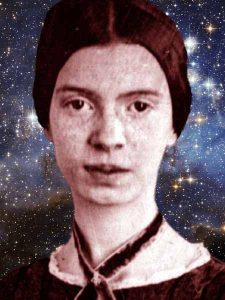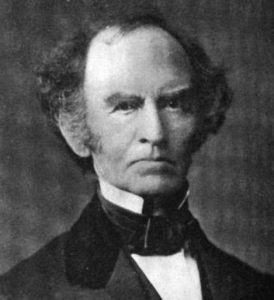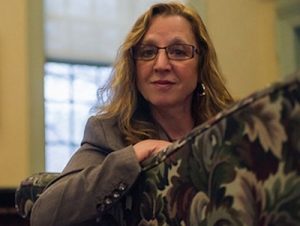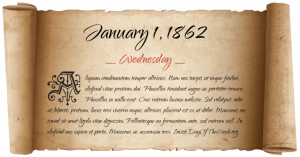The Start of the Year at the White Heat.
 We begin this year-long exploration of one of Emily Dickinson’s most productive periods as a poet by focusing on the events of January 1-7, 1862. One of the most poignant issues for Dickinson was the American Civil War, which is why we start by examining some of the implications of the War for her work. The popular myth of Dickinson as a recluse perpetuated the idea that she was a poet apart from the world and its turmoil, but her writing reveals connections with the Civil War that prove this damaging assumption to be false.
We begin this year-long exploration of one of Emily Dickinson’s most productive periods as a poet by focusing on the events of January 1-7, 1862. One of the most poignant issues for Dickinson was the American Civil War, which is why we start by examining some of the implications of the War for her work. The popular myth of Dickinson as a recluse perpetuated the idea that she was a poet apart from the world and its turmoil, but her writing reveals connections with the Civil War that prove this damaging assumption to be false.
This week’s news heavily centered on the War, still fairly new in the country’s mind, as the second anniversary quickly approached in April 1862.
“Breaking the Backbone of the System”
INTERNATIONAL NEWS
Ireland officially announced that if Britain became involved in the American Civil War or declared war anew on the United States, it would take the side of the US against Britain. Whether that would be the North or the South was never specified. This decision was sparked by the Trent Affair and provided a big confidence boost to the States, especially the North.
 Also, news of the death of Prince Albert, beloved consort of Queen Victoria of England, on December 14 reached the United States. His death inaugurated a Victorian culture of mourning (Victoria dressed in black for the rest of her life), but events in Britain laid the backdrop for this culture: Alfred Lord Tennyson's popular elegiac poem, “In Memoriam” (1849) and the preoccupations of the late Romantics with dying and death. Tennyson's influence on Dickinson will be explored in next week's post. Many thanks to my colleague Colleen Boggs for this information.
Also, news of the death of Prince Albert, beloved consort of Queen Victoria of England, on December 14 reached the United States. His death inaugurated a Victorian culture of mourning (Victoria dressed in black for the rest of her life), but events in Britain laid the backdrop for this culture: Alfred Lord Tennyson's popular elegiac poem, “In Memoriam” (1849) and the preoccupations of the late Romantics with dying and death. Tennyson's influence on Dickinson will be explored in next week's post. Many thanks to my colleague Colleen Boggs for this information.
NATIONAL NEWS
The year 1862 starts in the throes of the second year of the American Civil War. This week, all is quiet – the Civil War saw no major battles recently and what battles there were the North won “handsomely” and tidied up “nicely” in the words of the Springfield Republican.

Notable, however, was the debate regarding emancipation of all enslaved people in the South, which would be announced later this year.
Both the Springfield Republican and the Atlantic Monthly ran op-eds about the debate. The opposing sides included those who saw emancipation as a strategic misstep that would give the South reason to say the North took away its freedom to enslave people, and those who supported emancipation for solely ethical and socially justified reasons. Springfield’s op-ed, entitled “What Are We Fighting For?” is a good example of the debate. Dickinson’s friends were mostly abolitionists, as was her father, but she did have some family who lived in the South and supported the Confederacy.
An arresting “Letter From A Missionary” ran in the local Hampshire Gazette. The author, a Christian missionary “to the Zulus in Africa,” describes the horrors of war and states what he believes the Civil War is about: liberation from slavery and “breaking the backbone of the system.” The Atlantic also ran historical pieces about President Thomas Jefferson and his views on slavery as an owner of enslaved people, and General Fremont’s “hundred days” before his controversial dismissal from the North’s army.
“Celebrating and Mourning”

This week, on January 1st, the Dickinson family celebrated Edward Dickinson’s fifty-ninth birthday. Dickinson had a close relationship with her father Edward, but his restricting parental control caused much strain. In a letter to Thomas Wentworth Higginson written in April of this year, Dickinson said of her father:
He buys me many Books – but begs me not to read them – because he fears they joggle the Mind (L261).
During this week, Dickinson wrote a letter to Edward Dwight, a former local pastor, which had a strange, comedic fate. A month before, Dickinson received a letter from Dwight informing her that his wife, Lucy Dwight, had died. The couple, who were family friends, lived in Amherst until Lucy fell ill. Dickinson thought Dwight the best pastor in town. She wrote a passionate letter in response lamenting his loss, but accidentally switched it with a letter to Charles Wadsworth, another minister she met in Philadelphia, to whom some biographers connect her romantically. Awkwardness ensued: a recent widower and family friend receives a letter which might have contained romantic yearnings, and the very much alive Mrs. Wadsworth wonders at her assumed death. Dickinson cleared the air and sent an adapted version of the last stanza of “There came a day at summer’s full”(F325, J322) to Mr. Dwight, and received a poem and a photograph of Lucy in return.
Reflection
Ivy Schweitzer
I tell people who ask about the motivation for this project, that Dickinson called me. That is why I created this year-long exploration of one of the most intense years in Dickinson’s writing life.  I am both a scholar of early American literature, with a particular focus on women, and a poet. Wanting to invigorate my relationship to poetry as a writer of it, I thought to immerse myself in all things Dickinson and get as close as I could to her writing process and to the texture and networks of her daily life. There are many exemplary biographies and accounts of Dickinson (see Resources) and no end of fascinating fan literature and fiction, but I wanted something more experiential and sustained.
I am both a scholar of early American literature, with a particular focus on women, and a poet. Wanting to invigorate my relationship to poetry as a writer of it, I thought to immerse myself in all things Dickinson and get as close as I could to her writing process and to the texture and networks of her daily life. There are many exemplary biographies and accounts of Dickinson (see Resources) and no end of fascinating fan literature and fiction, but I wanted something more experiential and sustained.
I had just finished a digital humanities project, The Occom Circle, a scholarly digital edition of works by and about Samson Occom (1723-1792), a Mohegan Indian leader, public intellectual and Christian minister. In the course of working on that project, I explored the Dickinson Electronic Archive, an innovative research and teaching tool created by a collective of Dickinson scholars in the wake of the recently digitized Dickinson manuscripts by Harvard University and Amherst College. The world of Dickinson scholarship had been revolutionized in 1981 by the publication of Ralph W. Franklin’s The Manuscript Books of Emily Dickinson, which afforded a unique view of Dickinson’s texts as she wrote (and rewrote and preserved) them. Since then, scholars have been busy “unediting” Dickinson’s writing, as Marta Werner expressed it in Emily Dickinson’s Open Folios: Scenes of Reading, Surfaces of Writing. That is, they have been “undoing” a century of editorial and critical work so that we can finally begin to read what Dickinson actually wrote. The digital form of Dickinson’s manuscripts is producing another revolution, again, according to Werner, that is
constellating these works not as still points of meaning or as incorruptible texts but, rather, as events and phenomena of freedom.
I wanted to explore and find a way to present Dickinson’s poems as events of freedom.
I wanted to use the digital technologies I learned about to share this immersive experience with a wider audience of poetry lovers, students of Dickinson, and folks interested in the US nineteenth-century. I test-drove a good deal of this approach in two iterations of a junior level colloquium on Dickinson I taught at my home institution of Dartmouth College, titled “New Dickinson: After the Digital Turn.” It was a revelation to see how our readings of the poems changed, deepened, and grew more complex and dynamic when we worked with the digital scans of the manuscripts. As my students often commented heatedly, they felt “gypped” when comparing printed versions of the poems with the manuscript images. How dare the editor make those choices about diction, syntax, line breaks, and the fixed length of Dickinson’s iconic dashes without telling us! they complained. This “new” way of reading Dickinson was further aided by the ease of finding contextual materials on the web like newspapers, magazines, Dickinson’s lexicon, information about the Civil War and others. That is what I imagined our blog posts would offer.
 And so, to the first week in January 1862.
And so, to the first week in January 1862.
Beyond the debates about the Civil War and why it was fought, Dickinson seems preoccupied with its effects, especially the nearness, prevalence, and arbitrariness of death. It is a commonplace that in the midst of life, we are all near to our mortality, but the line that haunts me in these poems is Dickinson’s description of dying as “passing into Conjecture’s presence.” We cross the boundary between life and death and so pass into a “presence,” but when it is personified as “Conjecture,” my mind starts buzzing. What would it be like to stand in the presence of Speculation, Guess, or another great Dickinson word from a related poem, “Because I could not stop for Death,” Surmise? Is this where she imagines death brings us: into a vast hall at the end of which presides a powerful Spirit whose demeanor and character we do not and cannot know? Whose character is Not-Yet-Knowing? Will we be devastated when we learn the true nature of this Spirit, or rapturous? or simply disappointed? This makes me think of the iconic line from Whitman’s answer to the child, who, in Song of Myself, Section VI asks, “What is the grass?” The speaker responds: “And to die is different from what any one supposed, and luckier.”
I am also struck by the speaker of “Unto like Story,” who remembers the tales of “Kinsmen” who died for their beliefs, who have “marched in Revolution,” and prays, “Let me not shame their/sublime deportments.” I have often pondered how we, how I, can live our lives in the light of our ideals and deepest-held beliefs. Especially in a time of perpetual war, of atrocities committed in our name in far-off places we will never see. And so, listening to the news every day, I try to put myself into the lives of the people I hear about in news stories, as a way to honor the dignity of their struggles and their humanity. And sometimes it takes the form of a poem, with words borrowed from Dickinson’s poems.
Adoptee
They call it attack of panic
when alarms clang in my head
as if I had swallowed fire drills,
forcing me back into the night,
under our hut, boots thumping overhead.
The teachers at my new school
gather me up, pressing me back into myself.
Before, I was surrounded by bustle.
Neighbors’ chatter, banging pots,
the bubble of simmering azuki beans
we loved to eat mashed with butter and sugar.
Sometimes, distant growls
measured how we shared the bush.
Here on our American street,
houses loom mutely on lawns.
Cars sleek as gazelle
slide soundlessly into garages.
New mother, corral my flying parts
my belly full of surmise,
tell me nothing can send me back.
Our entwined hands like long evenings
lit by a full moon.
Bio: Ivy Schweitzer is Professor emerita of English and Creative Writing, and Women’s, Gender and Sexuality Studies at Dartmouth College, where she taught American literature and WGSS courses. She is the editor of “White Heat.”
Sources
History
The Atlantic Monthly, volume 9, issue 51. January 1862
Hampshire Gazette, January 7, 1862
Harper's Monthly Magazine, January 1862
Springfield Republican, January 4, 1862



